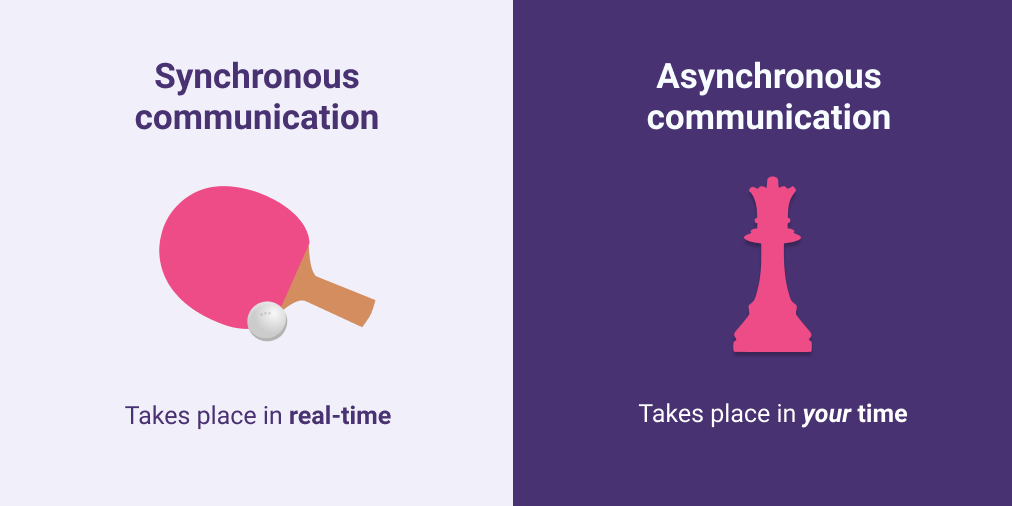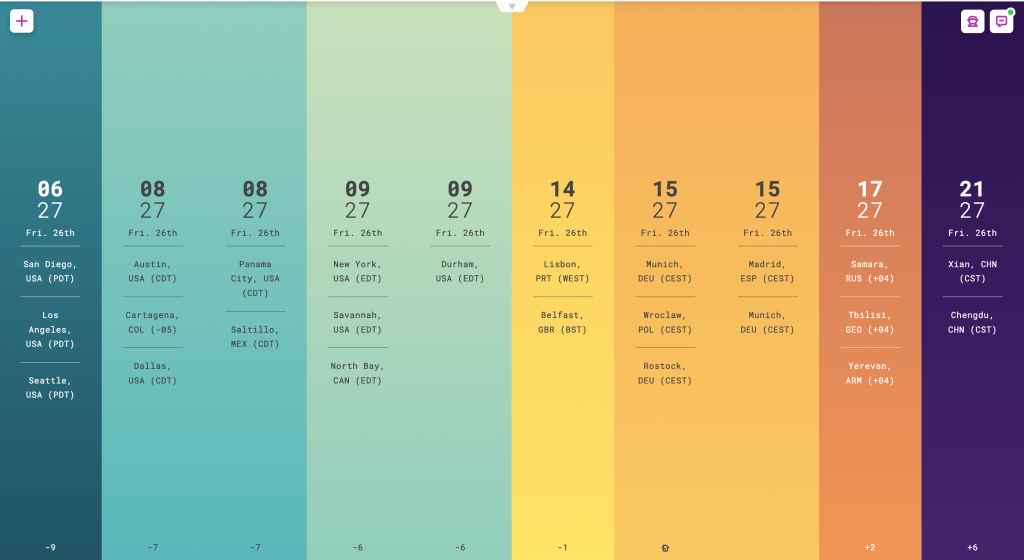Virtual vs Async Standups: Which is Right For Your Team?

If you’ve worked in an office, the chances are you’ve run a virtual standup, but maybe not an async standup.
But standing in front of your webcam following the same meeting routine over and over again doesn’t work. Especially when you’re in different time-zones or more on the introverted side.
When you switch to virtual or async standups, you must rethink your approach to those daily meetings.
In this blog we help you discover which approach is right for you. We cover the following topics:
💡 Check out our Daily standups hub for all our resources on running better standup meetings
What is a virtual standup meeting?
A virtual standup (or remote standup) is a meeting you hold in real time using a digital conferencing tool, like Zoom or Teams. These meetings typically follow the same format as an in-person standup, for example, by asking the three standard daily questions.
Benefits and pitfalls of virtuals standups
The advantage of remote standups is that they’re similar to in-person standups. If you’re familiar with those, switching to virtual is straightforward. You also unchain everyone from the office. That means you can continue your standup ritual even when people are working from home.
The disadvantage of remote standups is that… they’re similar to in-person standups. While switching is easy, you’ll bring along the same problems of regular standups and introduce a few new ones. For example, you may find that:
- 😴 Standups go way past the 15-minute limit too often
- 📣 Extroverts talk too much and crowd out introverts
- 😖 People’s workflows are interrupted disrupting focus
- 😔 Team members are less able to enjoy flexible working hours
- 🏢 Synchronous virtual standups damage work-life balance for anyone outside of the team’s dominant timezone
What is an asynchronous standup meeting?
An async standup lets people hold standups without participating or being present at the same time or in the same place. You achieve this by transforming the daily standup’s elements into ones that work in writing on asynchronous communication tools like Slack bots or Parabol.

For example, instead of answering standup questions verbally, people write out their answers and post them in Parabol or a Slack channel on their own time during the day.
Benefits and pitfalls of async standups
Asynchronous standups offer many benefits over virtual and in-person ones.
- 🌙 No meetings at odd hours for people in different time-zones.
- 🕦️ Team members contribute at a time that suits their workflow and life.
- 🤗 Standups are more inclusive because introverts can share their ideas in a relaxed manner with time to think and without being put on the spot.
- 🧘🏽♀️ Contributions are more thoughtful since people have time to think before writing or speaking.
- 🔍️ Information is written down and becomes organized, linkable, and searchable.
Async standups do have some pitfalls. For example, async standups rely on people reading or watching each others’ updates. Whereas in a synchronous standup this happens automatically simply by being present in the meeting.
Parabol’s async standup tool overcomes this obstacle by showing all updates in a single grid view instead of a list, making it hard to miss input from other team members.

Another challenge with async standups is that you can’t address blockers and offer help on the spot since everyone gives their updates at different times. We’ll look at this challenge in more detail later.
Learn how to run an async standup in Parabol.
7 factors to find the right standup approach for your team
Every team is different, so there’s no one-size-fits-all approach to daily standups. But the 7 factors below can guide your search for the most suitable one.
So let’s put virtual vs async standups head to head and see what the most important considerations are.
The first three factors will give you the strongest sense of which approach is best for you. The other four allow more choices depending on your culture, personalities, and preferences.
🏢 1. Workspace
Where your team works from is the first factor to consider when picking a standup approach. An in-person standup is an excellent option if you’re all in the same office. But these days, who is?
A virtual meeting becomes more desirable once one person isn’t co-located, so everyone has the same context and environment to experience the meeting.
“The biggest challenge was solved by going remote… we thought it would be a good idea to have the German developers in a conference room and the Spaniards on the wire. It was not fair and people weren’t on the same level. When everyone was remote, we were all on an equal playing field”
Gerrit Hartig, Scrum Master at VMRay
🕔️ 2. Working hours
Your second consideration is working hours. A virtual standup is still an option if your team’s working hours are fixed irrespective of location.
For example, this situation could apply to a distributed customer service team that serves business customers from 9 am to 5 pm in a specific time zone.
You might want to consider an async standup if team members have different standard working hours. Some people choose not to work mornings because they are more productive in the evenings. If you have that kind of flexibility, async standups might be for you.

🌎️ 3. Timezone
Your coworkers’ time zones are the third factor to inform your daily standup approach. You can go for a real-time, virtual standup when everyone has a workable time-zone crossover, such as the USA’s morning and Europe’s afternoon.
But if your team is distributed across the globe, virtual synchronous standups can negatively impact peoples’ work-life balance.
Say you have team members from Amsterdam to Sydney. These two cities have an eight-hour time difference, so you could hold a standup at the day’s end in Sydney and Amsterdam’s start.

Parabol’s time-zone distribution in August 2022. We run asynchronous standups because it’s the end of the day in China by the time colleagues in the US are waking up.
You can still make real-time check-ins work when your team works from two sides of the same ocean. Once two water bodies get involved, your only realistic option is an async standup.
If you add a team member in San Francisco to the Sydney and Amsterdam example above, you no longer have any reasonable time slot for everyone involved. In that case, async standups become your only option (unless you’re a team of night owls 🦉).
🧑🏼🤝🧑🏿 4. Personalities
The personalities on your team can help inform which type of daily standup suits them best.
In theory, real-time approaches work well for extroverts since they give them a chance to talk and connect with others. In reality, defaulting to a real-time format because you have an extroverted team creates two problems:
- Extroverts like to talk, so keeping your daily standup short becomes even more challenging than it already is.
- 57% of the population are estimated to be introverts. That figure means you’ll rarely find a team exclusively made up of extroverts.
Async standups give introverts a chance to consider their responses while not facing the pressure of speaking in front of a group. And extroverts can’t hijack the meetings because there are none.
🗣️ 5. Communication style
Introversion versus extroversion influences this preference, but there’s another consideration: different people favor different communication styles. Some like to talk, while others prefer to think, write, and then perhaps speak.
Companies ranging from Amazon to Zapier have their teams write proposals, plans, and points before meetings. All attendees then spend the first part of the gathering reading through those documents in silence before doing what’s typical in meetings: talking.
“The reason writing a good 4 page memo is harder than ‘writing’ a 20 page powerpoint is because the narrative structure of a good memo forces better thought and better understanding of what’s more important than what, and how things are related.”
Jeff Bezos, Amazon Founder, in a staff email
This writing practice ensures people have to think through their proposals and responses, as you don’t get away with blurting out something on paper.
An async standup has this benefit embedded. Let people first write answers, agenda points, and other input before the start of the meeting so it’s thoughtful and everyone else can read through others’ responses in advance. Then use the real-time time you have together to ask questions and discuss.
👨🏽💼 6. Working style
Most of your day consists of meetings and calls when you’re in management, sales, or customer support. With such a Manager’s Schedule, you can plan your standups anytime you like.
On the other hand, programmers, designers, and writers prefer a Maker’s Schedule. They need long stretches of uninterrupted time to do their best work.
“One reason programmers dislike meetings so much is that they’re on a different type of schedule from other people… They generally prefer to use time in units of half a day at least. You can’t write or program well in units of an hour. That’s barely enough time to get started.”
Paul Graham in Maker’s Schedule, Manager’s Schedule
Async standups are therefore ideal for teams that include makers since they don’t have to interrupt their deep work for a meeting but can instead make their contribution at a time that suits them.
📒 7. Documentation
Unless you use a transcription tool or someone takes notes religiously during a real-time virtual standup, you lose what’s said forever.
That loss isn’t necessarily a problem, but a log of your meetings can help you to:
- Go back and search through information from past meetings, for example, to find topics for your retrospectives.
- Reference or quote excerpts from previous standups in plans or proposals.
- Start threads to continue and follow up on specific topics later.
Virtual vs async standups quiz
Now that you know the 7 factors to consider, follow these steps to pick the right daily standup for your team. Try our short quiz to determine which one is right for you.
Remember to tailor your standup practice and format
With your approach selected, you can further tailor specific elements of your standup. Here are common issues for each type, some with links to more details and tips.
For real-time, virtual standups:
- ⏱️ Use a timer and assign a timekeeper to keep the meeting short.
- 🤫 Set a strict time limit per speaker to prevent talkative extroverts from hijacking the session.
- 🤔 Consider alternatives to the morning standup if you’re all in the same time zone.
- 🌐 Pick a time that’s the least bad option for everyone affected if an ocean is involved.
- 🧩 Try out different standup formats or questions to keep participants engaged.
- 📅 Reduce the frequency from daily real-time standups to a few or just one per week (essentially creating a hybrid approach).
For async and hybrid standups:
- ✅ Set up reminders or pings in Slack/Teams, so people don’t forget to write their contributions.
- 🚧 Make sure blockers don’t go unnoticed since people might miss them in async communication. Tag others in messages, use an emoji to indicate a blocker (🔴), or create a separate communication channel for blockers.
- 💡 Have a common trigger for writing and sharing your standup contribution, even though that might be at a different time for most folks. Say, at the start of the day, before lunch, or at the day’s end.
- 📜 Agree on a formal time point that wraps up one day’s standup and starts the next, like midnight Eastern Time.
- 👋 Add other meeting types to complement the lack of real-time interaction. For example, more one-on-ones or an optional virtual weekly watercooler.
Daily standup tools for virtual and async meetings
With your meeting approach locked in and tailored, you can select helpful daily standup tools for your team.
Tools for running your standups
Video-conferencing tools like Zoom, Google Hangouts, or Teams are essential for holding real-time remote standups. You should also ensure participants have good cameras, microphones, and internet connections for such meetings.
For async standups, you can use email, a channel in Slack, or a purpose-built tool like Parabol.
Our solution saves your entire team time and addresses many of the issues with async standups we’ve reviewed in this article. You can share updates on your own time, set a cadence that suits your team, and see everyone’s contributions in one view.
Other tools to support your standups
Here are a few other apps and services that can improve your standups:
- Automated transcriptions: Most popular video conferencing tools offer some built-in transcription features. You can also use third-party tools like Otter.ai, Grain, or Rev.
- Video recording tools: Apps like Loom, Grain, or Soapbox let you record a short video to go along with a written update. Handy for those who prefer speaking or when you need to give more detail on an intricate topic.
- Timezone planners: A timezone planner like The World Clock Meeting Planner, Worldtimebuddy, or FIO (Figure it Out) helps find meeting times that work for your team.
- Random icebreaker generator: Use our random icebreaker generator to start every virtual standup by checking in with each other.
Virtual and async standup FAQs
Here are a few other common questions we’ve seen on the topic of virtual vs async standups:
What’s a Slack virtual standup?
Teams holding a virtual standup in Slack typically answer the same set of questions about their day’s work in a dedicated messaging channel.
Common problems with Slack standups are that people forget to post their updates, and when they do, others don’t read them.
What’s a remote daily Scrum?
A remote daily Scrum is a virtual version of the daily standup for Scrum teams, as prescribed in the official Scrum Guide. Some folks mean a virtual standup in real-time when they say, “remote daily Scrum,” while others mean an async format.
Read the Daily Scrum: Complete Beginner’s Guide for more details on how Scrum thinks about the daily standup.
What are some meeting agendas for virtual standups
To move away from the daily standup’s typical questions and format, you can try a needs-based standup or Walk The Board.
With the needs-based form, you only hold a standup when you have enough blockers to necessitate one. When walking the board, a Sprint or Kanban board drives the meeting agenda, not the attendees or a set of questions.
Read more about these and other formats in 14 Daily Standup Formats to Try With Your Team.
💡 Check out our Daily standups hub for all our resources on running better standup meetings






